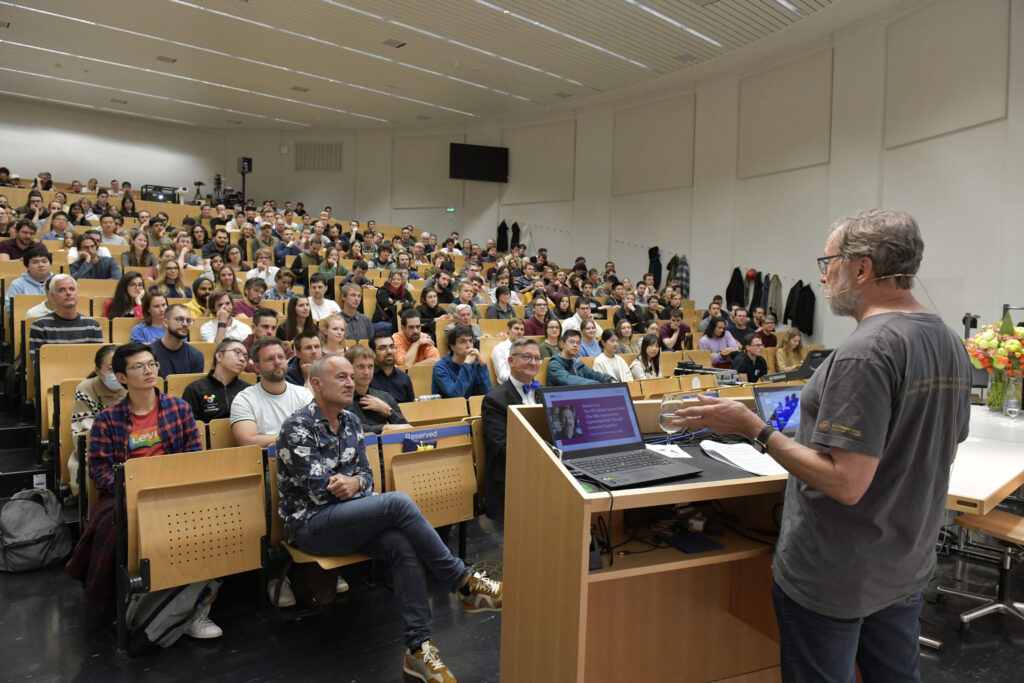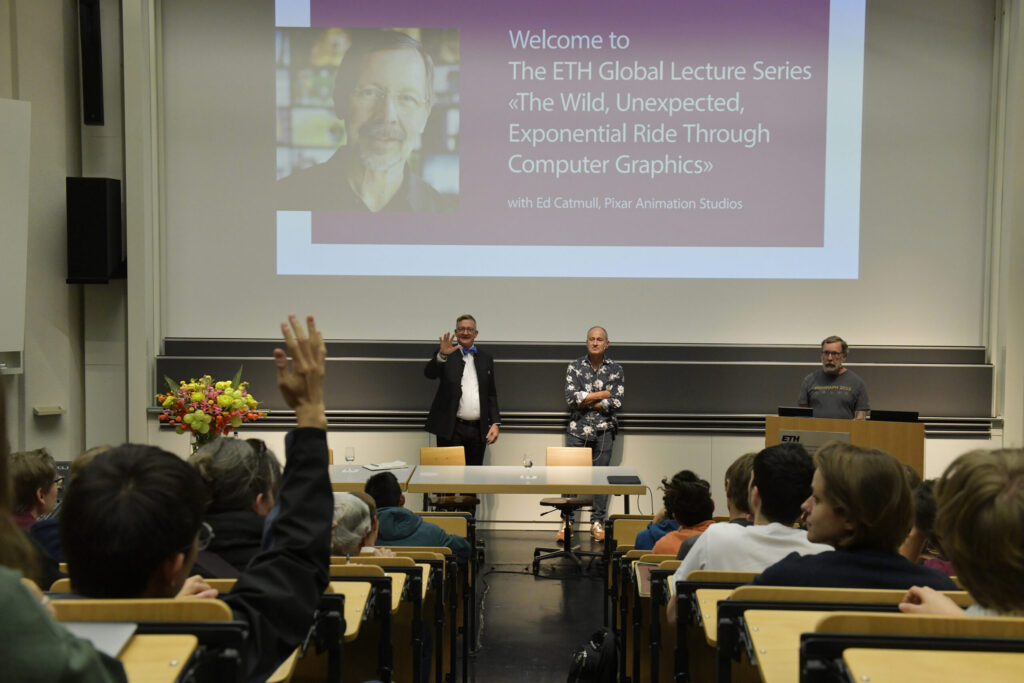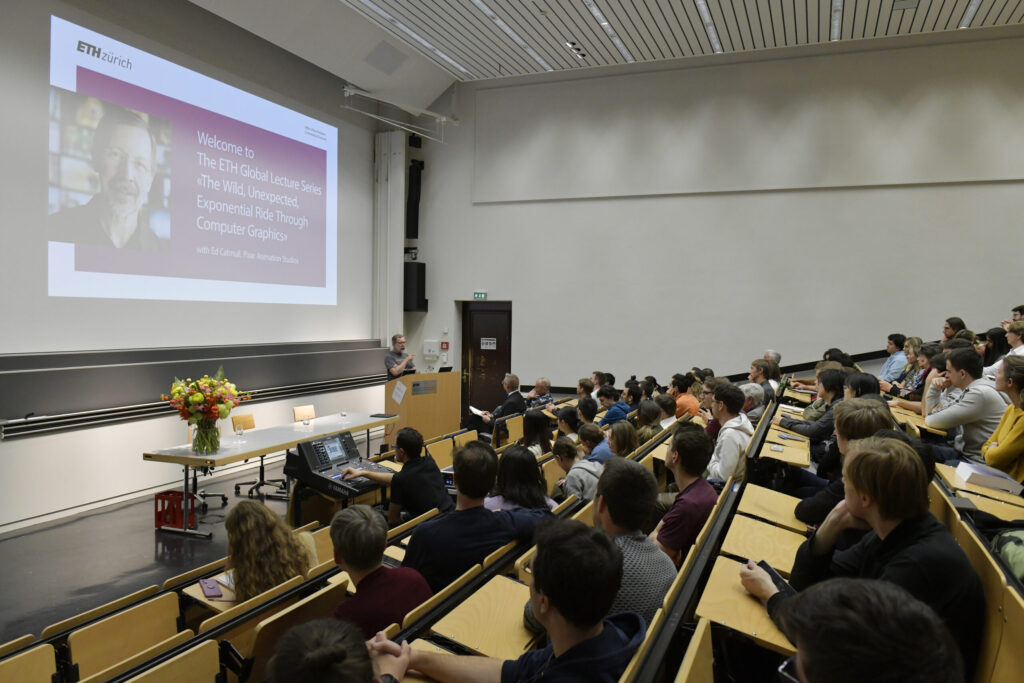Almost as soon as it was announced, the Global Lecture Series edition featuring 3D computer graphics pioneer, Ed Catmull, was sold out.
Tales From The 3D Front
Onome Ekeh, 8 December 2022
A legend in the world of digital animation, Catmull, a computer scientist, is co-founder of the internationally renowned and beloved Pixar studios, and an alumni of Walt Disney Animation, as well as Industrial Light & Magic. He is the recipient of numerous awards including four Oscars, a Turing, and a John von Neumann—and as such has covered all the bases within that improbable overlap of science and entertainment. ETH Zurich's Professor of Computer Science and Director of the Computer Graphics Laboratory Marcus Gross (who is also Director of Disney Research in Zurich), was on hand to introduce Catmull who, as his mentor, taught him a thing or two about navigating the precipices of corporate Hollywood as a scientist.
Catmull promised to stick to a strict script (he didn’t), and warned the audience “I have a lot of rabbit holes I can go down and never come out…” (True words!). All in all, it made for a heady deep dive into a singular career shaped by equal parts artistic ambition, scientific curiosity, and acquired management skills. Some highlights:
Would Be Animator Studies Physics Instead
True story: “I originally wanted to be an animator and in high school I was a good artist, but as I got near graduation, I realised that I was nowhere good enough, so I switched over into physics.” While everyone else had the same reaction to his course correction, Catmull didn’t find the two fields mutually exclusive. He saw them as aligned, which delivering insight into his particular trajectory. He ended up getting two bachelor’s degrees, one in physics and the other in computer science. He got hooked into computer science because of his interest in AI and the “exciting problems” at the frontier of this burgeoning field.
That Time When Someone Presented a Laptop in 1969 in Las Vegas
One of his professors, the brilliant Alan Kay, a Turing award winner, was ripped apart at a conference in Las Vegas for showing the mockup of a laptop computer with a fold-up screen—all the way back in the late 60s. It was then Catmull understood the implications of pitching linear projections against exponential advance i.e. Moore’s Law, which states that technology increases exponentially while utilising shorter timeframes. This tenet came in handy later when he found himself heading ambitious entities like Pixar or Disney.
Reverse Engineering Future Memory
Working with an algorithm created by John Warnock of Adobe, Catmull figured out he could make animations—except the computing at the time didn’t possess enough memory to create the fluidity of form and motion he sought. So it occurred to him to emulate the future: “…at some point we're going to have enough memory, so maybe I can fake having the memory…” From here he reverse-engineered the math, then transformed the math into a set of rules and operations. It became an 18-page thesis, which he showed to a friend, and over a few years they collaborated on it, published it, and then presented it at SIGGRAPH (Special Interest Group on Computer Graphics and Interactive Techniques). This side project ended up becoming the basis for one of the first Pixar animations. It also became one of the first open-source documents he shared, and is now a primary modelling tool in the film industry.
Catmull promised to stick to a strict script (he didn’t), and warned the audience “I have a lot of rabbit holes I can go down and never come out…” (True words!). All in all, it made for a heady deep dive into a singular career shaped by equal parts artistic ambition, scientific curiosity, and acquired management skills. Some highlights:
Would Be Animator Studies Physics Instead
True story: “I originally wanted to be an animator and in high school I was a good artist, but as I got near graduation, I realised that I was nowhere good enough, so I switched over into physics.” While everyone else had the same reaction to his course correction, Catmull didn’t find the two fields mutually exclusive. He saw them as aligned, which delivering insight into his particular trajectory. He ended up getting two bachelor’s degrees, one in physics and the other in computer science. He got hooked into computer science because of his interest in AI and the “exciting problems” at the frontier of this burgeoning field.
That Time When Someone Presented a Laptop in 1969 in Las Vegas
One of his professors, the brilliant Alan Kay, a Turing award winner, was ripped apart at a conference in Las Vegas for showing the mockup of a laptop computer with a fold-up screen—all the way back in the late 60s. It was then Catmull understood the implications of pitching linear projections against exponential advance i.e. Moore’s Law, which states that technology increases exponentially while utilising shorter timeframes. This tenet came in handy later when he found himself heading ambitious entities like Pixar or Disney.
Reverse Engineering Future Memory
Working with an algorithm created by John Warnock of Adobe, Catmull figured out he could make animations—except the computing at the time didn’t possess enough memory to create the fluidity of form and motion he sought. So it occurred to him to emulate the future: “…at some point we're going to have enough memory, so maybe I can fake having the memory…” From here he reverse-engineered the math, then transformed the math into a set of rules and operations. It became an 18-page thesis, which he showed to a friend, and over a few years they collaborated on it, published it, and then presented it at SIGGRAPH (Special Interest Group on Computer Graphics and Interactive Techniques). This side project ended up becoming the basis for one of the first Pixar animations. It also became one of the first open-source documents he shared, and is now a primary modelling tool in the film industry.
Back Then Disney Wasn’t Interested
In his graduate school days, Catmull’s professor, in support of his animation aspirations, arranged an exchange with Disney Studios: Catmull would be sent to Burbank and an animator would come to work with the Computer Science department at the University. Over at Disney, to his dismay, they aren’t interested in using his computer graphic skills for animation, rather they want him to work on their Space Mountain Ride. Disappointed, he feels resigned to a job in academia; if Disney, the industry giant has no interest, who would?
… Also, Most Universities Don’t Consider CG Legit
It wasn’t just Disney. During his job search, Computer Graphics was not considered a bona fide computer science—more like an afterthought. Fortunately, he got a call from the New York Institute of Technology. The then president of the college saw computer graphics as the future—and an important part of it.
There’s Good News and Bad News
NYIT was willing to invest in the development of Computer Graphics, that was the good news. Bad news: there was the idea that programmers would eventually replace artists. The bad news is still in debate.
The Manager
Something Catmull picked up working on algorithms was that management is really interesting. He considered himself a researcher, but began to develop theories on how to manage groups; for example, if he hired passionate, self-motivated people, perhaps they could self-organise and solve all the problems, and he could focus on research. He discovered this to be the wrong idea, but it sparked a career-long curiosity about the balance of research, craft, and managing human resources.
Industrial Light & Magic
George Lucas was the first industry person with credibility to invest in Computer Graphics. Catmull was hired by Lucasfilm in 1979, moving out to Marin County to form the Graphics Group division of the company. Lucas not only wanted to transform the industry, he wanted to nurture this transformation: he supported Catmull and his cohort in publishing their research.
Steve Jobs
Catmull enjoyed a good friendship with Steve Jobs who at acquired Pixar around the same time he had been ousted (temporarily) from Apple, and was building up NeXt. He actually worked for Jobs longer than anyone else, so he witnessed the dramatic shift from a somewhat problematic industry figure to the clearheaded genius that created the new Apple. He described it as a “hero’s journey” where Jobs in his wilderness of mistakes was smart enough to figure out his ‘bad boy’ persona wasn’t actually working.
Moore’s Law
Moore’s Law looms large in Catmull’s trajectory: the idea that computational power increases exponentially, creating faster, more efficient and even smaller systems drove his business decisions and projections at ILM, Pixar and even Disney. He doesn’t outright say it, but this is possibly the baseline thinking behind the open-source policy of these industry leaders sharing their research with each other. Even Steve Jobs, who was notoriously secretive, was game to publish Pixar’s research—he knew this would attract the best people.
Of course the flip side of the equation came when hype blew these projections out of proportion, and there was a subsequent time lag in delivery. Toy Story took 15 years (longer than expected) to make, and Catmull advocated for some sobriety: “if you're going to take on some crazy vision, you damn well better think through the implications of what it's going to take to get there.”
For more wisdom and hard-earned advice from the frontline trenches of 3D Computing, watch the full lecture below:
In his graduate school days, Catmull’s professor, in support of his animation aspirations, arranged an exchange with Disney Studios: Catmull would be sent to Burbank and an animator would come to work with the Computer Science department at the University. Over at Disney, to his dismay, they aren’t interested in using his computer graphic skills for animation, rather they want him to work on their Space Mountain Ride. Disappointed, he feels resigned to a job in academia; if Disney, the industry giant has no interest, who would?
… Also, Most Universities Don’t Consider CG Legit
It wasn’t just Disney. During his job search, Computer Graphics was not considered a bona fide computer science—more like an afterthought. Fortunately, he got a call from the New York Institute of Technology. The then president of the college saw computer graphics as the future—and an important part of it.
There’s Good News and Bad News
NYIT was willing to invest in the development of Computer Graphics, that was the good news. Bad news: there was the idea that programmers would eventually replace artists. The bad news is still in debate.
The Manager
Something Catmull picked up working on algorithms was that management is really interesting. He considered himself a researcher, but began to develop theories on how to manage groups; for example, if he hired passionate, self-motivated people, perhaps they could self-organise and solve all the problems, and he could focus on research. He discovered this to be the wrong idea, but it sparked a career-long curiosity about the balance of research, craft, and managing human resources.
Industrial Light & Magic
George Lucas was the first industry person with credibility to invest in Computer Graphics. Catmull was hired by Lucasfilm in 1979, moving out to Marin County to form the Graphics Group division of the company. Lucas not only wanted to transform the industry, he wanted to nurture this transformation: he supported Catmull and his cohort in publishing their research.
Steve Jobs
Catmull enjoyed a good friendship with Steve Jobs who at acquired Pixar around the same time he had been ousted (temporarily) from Apple, and was building up NeXt. He actually worked for Jobs longer than anyone else, so he witnessed the dramatic shift from a somewhat problematic industry figure to the clearheaded genius that created the new Apple. He described it as a “hero’s journey” where Jobs in his wilderness of mistakes was smart enough to figure out his ‘bad boy’ persona wasn’t actually working.
Moore’s Law
Moore’s Law looms large in Catmull’s trajectory: the idea that computational power increases exponentially, creating faster, more efficient and even smaller systems drove his business decisions and projections at ILM, Pixar and even Disney. He doesn’t outright say it, but this is possibly the baseline thinking behind the open-source policy of these industry leaders sharing their research with each other. Even Steve Jobs, who was notoriously secretive, was game to publish Pixar’s research—he knew this would attract the best people.
Of course the flip side of the equation came when hype blew these projections out of proportion, and there was a subsequent time lag in delivery. Toy Story took 15 years (longer than expected) to make, and Catmull advocated for some sobriety: “if you're going to take on some crazy vision, you damn well better think through the implications of what it's going to take to get there.”
For more wisdom and hard-earned advice from the frontline trenches of 3D Computing, watch the full lecture below:
About the Author

Onome Ekeh
A narrative conceptualist, Onome Ekeh was born and raised on both sides of the Atlantic, and is now based in Switzerland. Her work has appeared in literary, film, and technology journals in the U.S. and Europe. She lectures at FHNW Academy of Art and Design in Basel, and is currently at work on a volume of speculative fiction.





